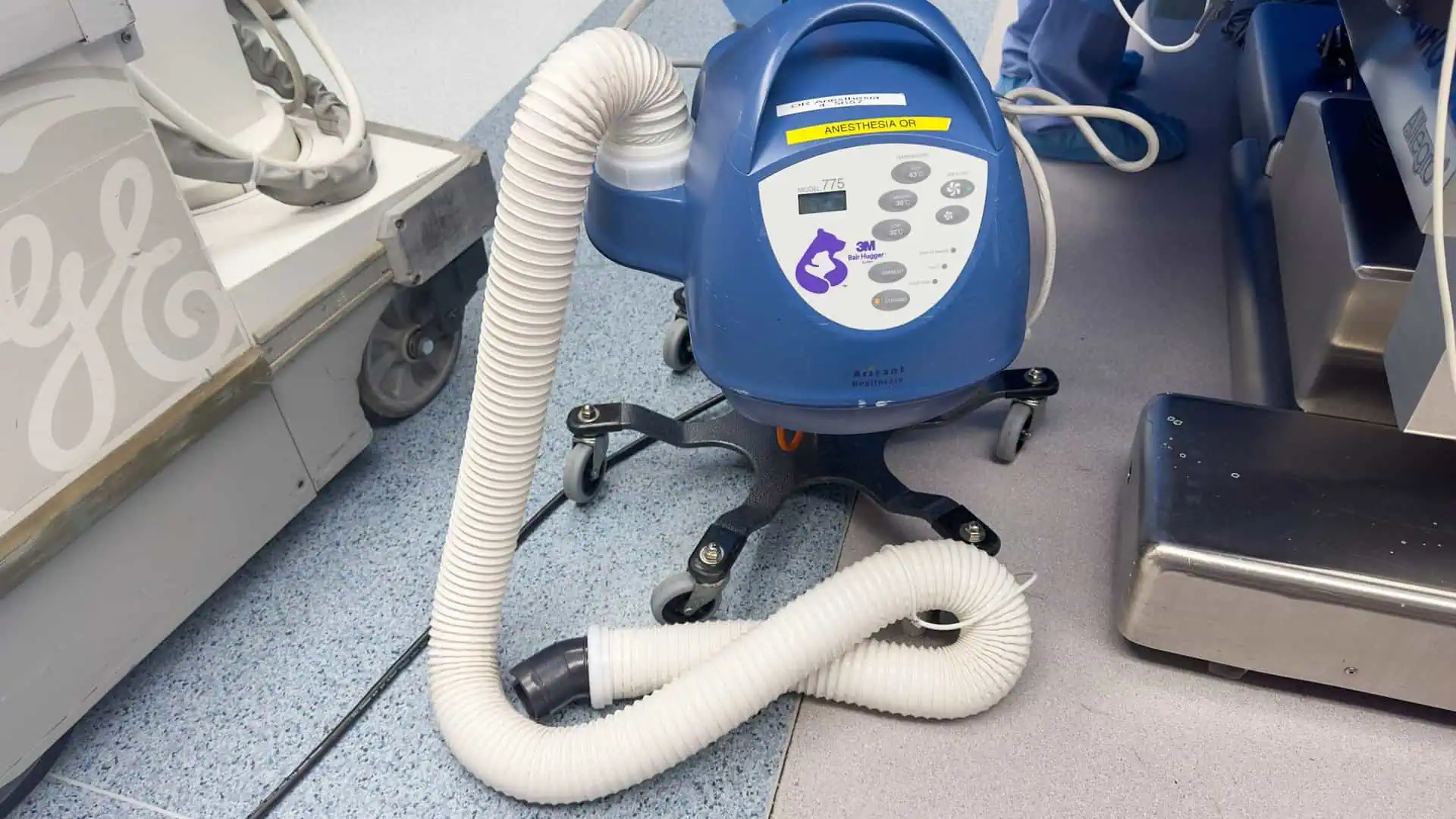Bair Hugger Warming Blanket Lawsuit
- Last Updated: June 12th, 2025

Attorney Jessica Paluch-Hoerman, founder of TruLaw, has over 28 years of experience as a personal injury and mass tort attorney, and previously worked as an international tax attorney at Deloitte. Jessie collaborates with attorneys nationwide — enabling her to share reliable, up-to-date legal information with our readers.
Legally Reviewed
This article has been written and reviewed for legal accuracy and clarity by the team of writers and legal experts at TruLaw and is as accurate as possible. This content should not be taken as legal advice from an attorney. If you would like to learn more about our owner and experienced injury lawyer, Jessie Paluch, you can do so here.
Fact-Checked
TruLaw does everything possible to make sure the information in this article is up to date and accurate. If you need specific legal advice about your case, contact us by using the chat on the bottom of this page. This article should not be taken as advice from an attorney.
Key takeaways:
- The 3M Bair Hugger warming blanket, used in surgeries to maintain body temperature, has been linked to severe infections, particularly during joint replacement procedures, due to its alleged design defect that may introduce bacteria into surgical sites.
- Patients who developed serious infections, such as deep joint infections requiring multiple surgeries and long-term treatment, after procedures using the Bair Hugger blanket are filing lawsuits against the manufacturer 3M, claiming the company concealed and failed to warn about the device's risks.
- The Bair Hugger litigation has broader implications for the medical device industry, emphasizing the importance of ongoing safety monitoring, transparent risk communication, and potentially influencing future lawsuits and regulatory practices, while also leading to changes in hospital practices to ensure patient safety.
- Lawyers are actively accepting new clients who have suffered infections due to the 3M Bair Hugger blanket, and affected patients are encouraged to reach out for support.
Overview of the Bair Hugger Lawsuit
On this page, we’ll provide an overview of the Bair Hugger lawsuit, allegations in the Bair Hugger lawsuit, injuries claimed in the Bair Hugger lawsuit, and much more.
The Bair Hugger warming blanket, developed by 3M, has sparked substantial legal challenges due to allegations that its use during surgeries has led to critical medical complications, particularly deep joint infections.
The use of air warming blanket technology in surgical settings continues to be a topic of debate in the medical community.
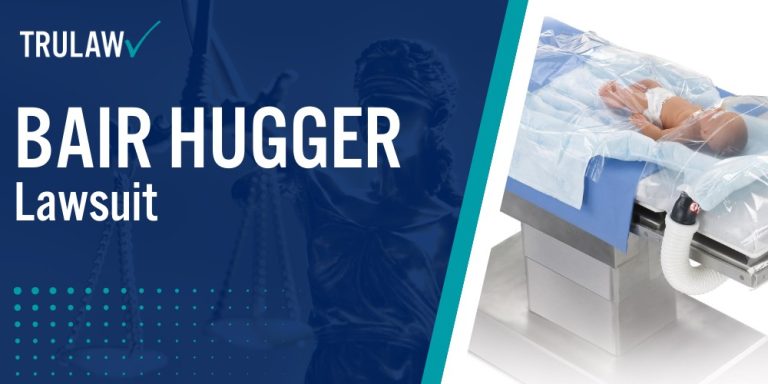
Intro to the Bair Hugger Lawsuit
Introduced in 1987, the device is designed to maintain a patient’s body temperature during surgery, but plaintiffs argue that it has caused more harm than good.
Key aspects of the Bair Hugger lawsuit include, but are not limited to:
- Inadequate Warming Claims: Plaintiffs have alleged that the device fails to provide sufficient warmth, leading to hypothermia and subsequent complications during surgery.
- Infection Risk: The most significant concern centers on claims that the device circulates contaminated air, increasing the risk of serious infections, particularly in patients undergoing joint replacement surgeries.
If you or someone you love has developed an infection or severe medical conditions after using a Bair Hugger warming blanket, you may qualify to pursue compensation.
Contact TruLaw using the chat on this page to receive an instance case evaluation and determine your eligibility to join others in filing a Bair Hugger lawsuit today.
Table of Contents
Bair Hugger Lawsuit Updates
-
May 2025 Updates:
May 1, 2025: May 2025 JPML Update
The Bair Hugger lawsuit involves claims that the surgical warming blanket system has led to serious post-operative infections by disrupting sterile airflow during surgery.
Plaintiffs allege that the device’s design allowed bacteria to enter surgical sites, causing deep joint infections and other complications.
208 cases have been added to the Bair Hugger MDL in the past month.
This growth has been consistent throughout this year, with 565 cases added to the litigation since January 1st.
Infections linked to the Bair Hugger system can result in extended hospitalizations, additional surgeries, and long-term health effects.
If you or a loved one underwent hip or knee replacement surgery and suffered from a deep joint infection, you may be eligible to take action and file a Bair Hugger Lawsuit.
Contact TruLaw today for a free consultation.
Use the chatbot on this page to find out if you qualify to file a Bair Hugger Lawsuit and to get in touch with a licensed lawyer.
-
April 2025 Updates:
April 1, 2025: April 2025 JPML Update
The Bair Hugger lawsuit centers on claims that the surgical warming blanket system has caused deep joint infections by disrupting airflow in operating rooms.
Plaintiffs allege that the device design increases the risk of harmful bacteria reaching open surgical sites, leading to serious post-operative complications.
113 cases have been added to the Bair Hugger MDL in the past month.
This growth reflects ongoing concern and legal action from patients who experienced severe infections after surgery.
These infections can result in extended hospital stays, revision surgeries, and long-term health consequences.
If you or a loved one underwent hip or knee replacement surgery and suffered from a deep joint infection, you may be eligible to take action and file a Bair Hugger Lawsuit.
Contact TruLaw today for a free consultation.
Use the chatbot on this page to find out if you qualify to file a Bair Hugger Lawsuit and to get in touch with a licensed lawyer.
-
March 2025 Updates:
Bair Hugger warming blankets are devices used in surgical settings to maintain a patient’s body temperature during procedures.
They function by delivering warm air through a disposable blanket, aiming to prevent hypothermia—a condition where the body loses heat faster than it can produce it—during surgery.
While designed to prevent hypothermia, concerns have arisen regarding the Bair Hugger’s potential to increase the risk of surgical site infections.
- Airborne Contaminants: The forced-air mechanism may disturb particles from the operating room floor, potentially introducing bacteria into the surgical field.
- Disruption of Sterile Field: The continuous airflow could disrupt the laminar flow of air designed to keep the surgical area sterile, possibly leading to contamination.
- Device Contamination: If the warming unit’s filters are not changed regularly, bacteria may accumulate within the device and be dispersed into the operating room air, increasing infection risk.
Studies have indicated a potential association between the use of forced-air warming devices like the Bair Hugger and an increased risk of deep joint infections, particularly following orthopedic surgeries such as hip and knee replacements.
It’s important to note that 3M, the manufacturer of Bair Hugger devices, maintains that their products are safe and effective, stating that maintaining a normal body temperature with forced-air warming can reduce the risk of infection.
Thousands of patients have filed lawsuits alleging that the Bair Hugger warming blanket was responsible for infections they experienced after surgery.
These legal actions claim that 3M failed to adequately warn about the potential risks associated with the device.
If you or a loved one underwent hip or knee replacement surgery and suffered from a deep joint infection, you may be eligible to take action and file a Bair Hugger Lawsuit.
Contact TruLaw today for a free consultation.
Use the chatbot on this page to find out if you qualify to file a Bair Hugger Lawsuit and to get in touch with a licensed lawyer.
March 3rd, 2025: Bellwether Update
In March 2025, the number of cases in the Bair Hugger multidistrict litigation (MDL) saw a decrease, dropping by 48 cases, from 7,873 in February 2025 to 7,971 in March 2025.
February saw an increase of 146 cases, while March reported 98 new filings.
The Bair Hugger lawsuit involves individuals who have suffered infections and other serious complications after surgeries where the Bair Hugger warming blanket was used.
The device, designed to keep patients warm during surgery by circulating heated air, has been linked to a higher risk of bacterial infections, particularly deep joint infections, when the air it circulates may carry contaminants.
Plaintiffs claim that the manufacturers of the Bair Hugger device failed to warn medical professionals and patients about these risks.
If you or a loved one underwent hip or knee replacement surgery and suffered from a deep joint infection, you may be eligible to take action and file a Bair Hugger Lawsuit.
Contact TruLaw today for a free consultation.
Use the chatbot on this page to find out if you qualify to file a Bair Hugger Lawsuit and to get in touch with a licensed lawyer.
-
February 2025 Updates:
February 20th, 2025: Bair Hugger MDL Update: Bellwether Trial Moves Forward
The Bair Hugger Mass Tort, established in December 2015, is gaining momentum after years of legal challenges.
Last week, a judge in the Eastern District of Pennsylvania (EDPA) denied 3M’s motion for summary judgment and its attempt to exclude plaintiffs’ experts.
The court ruled that both general and specific causation experts met the legal standards under Rule 702, allowing their testimony to be presented to a jury.
With this ruling, the first bellwether trial in the Bair Hugger MDL is set to begin in April.
If you or a loved one underwent hip or knee replacement surgery and suffered from a deep joint infection, you may be eligible to take action and file a Bair Hugger Lawsuit.
Contact TruLaw today for a free consultation.
Use the chatbot on this page to find out if you qualify to file a Bair Hugger Lawsuit and to get in touch with a licensed lawyer.
February 19th 2025: Bair Hugger Warming Blanket: Infection Risks and Legal Concerns
The Bair Hugger Lawsuit is ongoing.
The Bair Hugger Warming Blanket is widely used in surgeries to maintain patient body temperature and reduce complications.
However, growing concerns suggest it may increase the risk of infections, especially in joint replacement procedures.
How the Bair Hugger Warming Blanket May Cause Infections
- Disrupting the Sterile Field: The device uses forced-air warming, which can stir up airborne contaminants in the operating room. These particles may settle into open surgical wounds, raising infection risks.
- Bacterial Contamination: If not properly maintained, the warming blanket itself can harbor harmful bacteria, potentially exposing patients to infections during surgery.
- Higher Risk for Joint Surgeries: Patients undergoing hip and knee replacements are particularly vulnerable. Bacteria introduced during these procedures can lead to deep joint infections, which are difficult to treat and may require additional surgeries.
Potential Infections Linked to the Bair Hugger Blanket
- Surgical site infections (SSIs)
- Deep joint infections (e.g., hip and knee replacements)
- Bacterial infections like MRSA
- Sepsis and bloodstream infections
- Pneumonia and respiratory infections
Legal Concerns and Lawsuits
Patients who developed infections after surgery have begun filing lawsuits against the makers of the Bair Hugger, claiming the device caused their complications.
These lawsuits allege that the manufacturer failed to warn patients and medical professionals about the risks.
If you or a loved one underwent hip or knee replacement surgery and suffered from a deep joint infection, you may be eligible to take action and file a Bair Hugger Lawsuit.
Contact TruLaw today for a free consultation.
Use the chatbot on this page to find out if you qualify to file a Bair Hugger Lawsuit and to get in touch with a licensed lawyer.
February 3rd, 2025: New Cases Added to the Bair Hugger Lawsuit
The Bair Hugger Lawsuit is ongoing.
The Bair Hugger lawsuit involves claims that the surgical warming blanket, commonly used during procedures to maintain patient body temperature, has led to severe infections.
Plaintiffs allege that the device disrupts airflow in operating rooms, increasing the risk of deep joint infections after surgeries.
In January, 7,727 cases were filed, increasing to 7,873 in February, with 146 new claims added.
This rise reflects growing concerns among patients who have suffered post-surgical infections allegedly linked to the Bair Hugger system.
Infections following surgery can lead to serious complications, including prolonged hospital stays, additional procedures, and long-term health consequences.
If you or a loved one developed a severe infection after surgery involving the use of a Bair Hugger forced-air warming blanket, you may be eligible to seek compensation.
Contact TruLaw using the chat on this page to receive an instant case evaluation that can determine if you qualify for the Bair Hugger lawsuit today.
-
January 2025 Updates:
Since the previous month, 55 new new lawsuits have been filed in the Bair Hugger warming devices MDL. A total of 7,727 lawsuits are now pending against 3M for harms believed to be caused by the blankets.
-
December 2024 Updates:
The multi-district litigation (MDL) against 3M, the manufacturer of the Bair Hugger Forced Air Warming Devices, recorded a total of 7,672 pending lawsuits at the beginning of the month.
The court has finalized key deadlines for three bellwether trials in the MDL) against the company, regarding claims that the device caused harm during surgery.
Expert depositions must be completed by December 2, 2024, and both sides should be prepared for trial by March 3, 2025.
These bellwether trials are expected to provide critical insight into potential outcomes for thousands of plaintiffs who allege injuries tied to the device.
Lawsuits continue to be filed as individuals come forward with claims of complications linked to the Bair Hugger system.
-
November 2024 Updates:
No major updates in the Bair Hugger Warming Blanket lawsuits have been announced, and no settlements have been reached. At this time, the litigation remains ongoing.
-
October 2024 Updates:
There have been no major developments in this litigation to report this month.
-
September 2024 Updates:
September 1st, 2024
The 3M Bair Hugger system litigation remains in a holding pattern, with no significant developments to report this month.
-
August 2024 Updates:
August 1st, 2024
The case has seen no significant updates since the last month.
-
July 2024 Updates:
July 1st, 2024
The number of plaintiffs in the Bair Hugger Forced Air Warming Devices Products Liability Litigation MDL has increased significantly.
The total number of filed lawsuits rose from 6,858 on June 1 to 7,187 on July 1.
-
June 2024 Updates:
June 18th, 2024
A Missouri appeals court has upheld a defense verdict in a case involving allegations against 3M Co.’s Bair Hugger patient warming system.
The court affirmed that the trial court’s evidentiary rulings were appropriate and that there was no abuse of discretion in limiting expert testimony.
The plaintiff, who had undergone knee surgery in November 2016 and later developed an infection, claimed that the Bair Hugger system was defectively designed and caused her postoperative infection.
Despite suing 3M for negligent and defective design, manufacturing, and marketing, a jury ruled in favor of 3M, and the plaintiff’s motion for a new trial was denied.
In her appeal, the plaintiff argued that the trial court unfairly restricted her cross-examination of 3M’s expert witnesses, hindering her ability to challenge their credibility.
However, the appeals court rejected this argument, noting that her legal team failed to provide necessary offers of proof to support her claims.
Furthermore, the plaintiff raised concerns about the trial court allowing remote testimony from an expert due to limited availability.
This issue was also addressed by the appeals court in their decision.
-
May 2024 Updates:
May 1st, 2024
The parties involved in the Bair Hugger multi-district litigation are gearing up for the trial proceedings scheduled to commence in March 2025, as outlined in the recent scheduling order by U.S. Magistrate Judge David T. Schultz.
Throughout the past year, both sides have actively engaged in settlement discussions under the guidance of Special Master and retired judge James M. Rosenbaum.
Despite ongoing efforts, a Bair Hugger settlement has not been reached, indicating the potential need for further trials to facilitate the settlement process.
Consequently, six specific cases have been collaboratively chosen for trial to expedite a timely and effective resolution.
In adherence to the scheduling order, all fact discovery must be finalized by September 3, 2024.
Plaintiffs are mandated to disclose their expert witnesses by the same date, while the defense’s disclosures are expected by October 1.
Depositions are slated for completion by November 1, and all dispositive motions must be submitted by November 29.
Additionally, a status conference with Judge Joan N. Ericksen is scheduled for March 19, 2025, further underscoring the significance of the impending trial proceedings.
-
April 2024 Updates:
April 9th 2024:
The 3M Bair Hugger mass tort litigation shows no signs of immediate resolution.
The MDL, which consolidated thousands of lawsuits nationwide, currently houses over 5,000 pending claims.
This makes it one of the largest product liability cases in the country.
While there haven’t been any major developments in recent months, both sides are strategizing for upcoming trials or potential settlements.
-
March 2024 Updates:
March 7th, 2024
The 3M Bair Hugger lawsuit remains largely unchanged in recent months.
The massive case, with over 5,000 claims, continues to be one of the biggest ongoing litigations in the country.
-
February 2024 Updates:
February 6th, 2024:
There have been no notable developments, revisions, or fresh insights concerning the 3M Bair Hugger lawsuit in recent months.
The multidistrict litigation (MDL) still encompasses over 5,000 pending claims, solidifying its position as one of the most substantial litigations nationwide.
-
January 2024 Updates:
January 1st, 2023:
There have been no significant updates, changes, or new information regarding the 3M Bair Hugger lawsuit in recent months.
The MDL remains at over 5,000 pending claims, making it one of the largest in the nation.
-
November 2023 Updates:
November 1st, 2023:
No noteworthy developments, alterations, or additional information concerning the 3M Bair Hugger lawsuit have been made in recent months.
The MDL continues to be one of the largest in the country, currently encompassing over 5,000 pending claims.
-
October 2023 Updates:
October 1st, 2023:
There haven’t been any significant developments, changes, or new information related to the 3M Bair Hugger lawsuit in recent months.
The MDL remains one of the largest in the country, with more than 5,000 currently pending claims.
-
September 2023 Updates:
September 1st, 2023:
The most recent report on the 3M Bair Hugger cases reveals a total of 5,251 pending claims within the multi-district litigation, making it the 8th-largest MDL in the country.
-
August 2023 Updates:
3M made a formal request to a Minnesota federal magistrate judge to continue presiding over an MDL concerning the company’s post-operative warming device.
This request came after plaintiffs expressed concerns about potential conflicts of interest, as the judge had previously held 3M shares and his wife had ties to the company.
The plaintiffs attempted to disqualify the MDL judge in addition to the presiding judge, citing confidential reasons.
However, their motion to disqualify the judge was ultimately rejected.
-
July 2023 Updates:
As thousands patients pursue compensation, the Bair Hugger Warming Blanket case remains unresolved.
Patients who have undergone a procedure utilizing Bair Hugger may qualify for significant financial compensation.
For guidance and support regarding the class action suit, contact TruLaw today.
-
June 2023 Updates:
The Supreme Court has refused to review 3M’s petition seeking a review of the re-established consolidated litigation related to Bair Hugger surgical warming blankets.
The company contends that the Eighth Circuit had applied an overly permissive standard by permitting expert witnesses for patients who had undergone joint-replacement procedures.
However, the Court indicated it had no interest in reviewing the case.
-
May 2023 Updates:
May 16th, 2023:
The Bair Hugger Warming Blanket case is still ongoing, several thousand patients have filed lawsuits and are continuing to do so.
If you are a patient who has undergone any procedure where Bair Hugger was used, you could be entitled to compensation.
Make sure to seek legal assistance through TruLaw for help with this ongoing class action suit.
-
April 2023 Updates:
April 17th, 2023:
n a case against 3M, plaintiffs have filed a disqualification motion against US District Judge Joan Ericksen and federal magistrate Judge David Schultz.
The motion alleges that Ericksen consulted a retired products liability defense attorney while considering a critical 3M motion, and Schultz’s financial adviser bought and sold 3M shares during the multidistrict litigation.
The plaintiffs claim that these actions caused bias in the case. 3M opposes the disqualification of the judges and denies the plaintiffs’ claims of causation.
-
March 2023 Updates:
March 17th, 2023:
With the rejection of the petition, 3M is expected to face thousands of infection lawsuits.
If a settlement agreement isn’t reached, the court will decide whether to proceed with bellwether trials or to remand the cases to their original courts for trials, which plaintiffs requested.
-
June 2022 Updates:
June 1st, 2022:
The Supreme Court has rejected 3M’s appeal in the Bair Hugger warming blanket lawsuits.
This comes after 3M and its subsidiary, Arizant Healthcare, filed a writ of certiorari petition with the Supreme Court in February 2022.
The petition sought to have the Court evaluate whether the Court of Appeals’ ruling was too lenient in allowing plaintiffs’ expert witness testimony, arguing that the testimony was unreliable.
However, the Supreme Court has upheld the Appeals Court’s decision.
-
February 2022 Updates:
U.S. District Judge Joan N. Ericksen appointed retired Magistrate Judge Arthur Boylan to mediate the Bair Hugger lawsuits.
The involved parties will correspond with Judge Boylan to schedule and attend mediation sessions he considers appropriate in these cases.
This means that over 5,200 active lawsuits involving the Bair Hugger blanket may potentially settle.
-
January 2022 Updates:
January 3rd, 2022:
The 8th U.S. Circuit Court of Appeals ruled that the MDL judge overseeing the warming blanket lawsuits wrongly excluded testimony from medical experts supporting the plaintiffs’ claims.
The Plaintiffs’ medical engineering expert opinions on causation could be derived from models and epidemiological that suggest a causal connection between infection and the Bair Hugger.
This is a significant setback for 3M, who is also the defendant in the defective earplug lawsuit that is the biggest mass tort in U.S. history.
Bair Hugger Lawsuit: Infections & Complications
The Bair Hugger warming blanket, widely used in surgeries, is at the center of major Bair Hugger lawsuits.
Patients claim this device caused severe infections during their procedures.
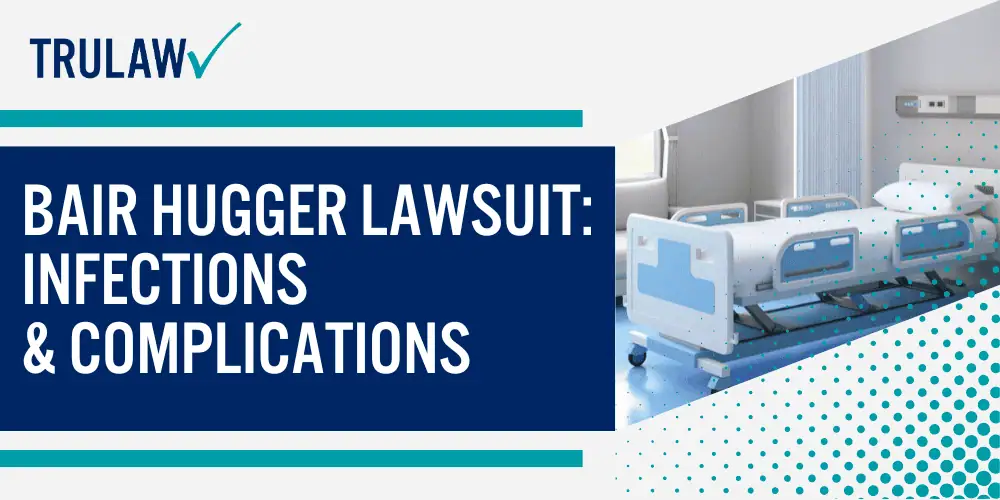
The lawsuit alleges that the Bair Hugger system, intended to maintain body temperature, may introduce harmful bacteria into surgical sites.
How Bair Hugger Blankets May Cause Infections
The Bair Hugger warming system has been associated with potential infection risks primarily due to its method of air circulation during surgery.
The device operates by drawing air from the operating room, warming it, and then releasing it through a disposable blanket placed over the patient.
The concern arises from the possibility that this air, which might carry airborne bacteria, could be directed towards the patient’s surgical site.
This mechanism raises questions about whether the system inadvertently introduces bacteria into open wounds, especially during procedures such as joint replacements.
Several factors contribute to the potential for infection when using Bair Hugger blankets:
- The device draws air from the operating room, which could contain airborne bacteria.
- Warmed air is released near the surgical site, potentially carrying contaminants.
- The air intake location may be near the operating room floor, a generally contaminated area.
These factors suggest that the Bair Hugger system’s design could potentially compromise the sterile environment required during surgery.
For instance, the device’s intake of air from the vicinity of the operating room floor, where contaminants are more likely to be present, may lead to bacteria being introduced into the patient’s surgical site.
This possibility has been supported by publications such as Infection Control and Hospital Epidemiology, which point to the device’s air intake mechanism as a contributor to surgical site contamination.
Bair Hugger Infections Linked to Joint Surgeries
Knee replacement surgery appears to have the highest risk of Bair Hugger-related infections.
These procedures are particularly vulnerable due to the depth of the surgical site and the presence of implants.
Deep joint infections can be extremely difficult to treat and may lead to long-term complications.
Patients undergoing knee, hip, or shoulder replacements should be aware of this potential risk.
The lawsuit claims that many individuals developed serious infections following joint surgeries where the Bair Hugger warming blankets were used.
A deep joint infection often required additional surgeries and extensive antibiotic treatments.
When and Why is the Bair Hugger Warming Device Used?
Bair Hugger devices are commonly used across the United States, with more than 80% of hospitals employing this technology to maintain patient body temperature during surgery.
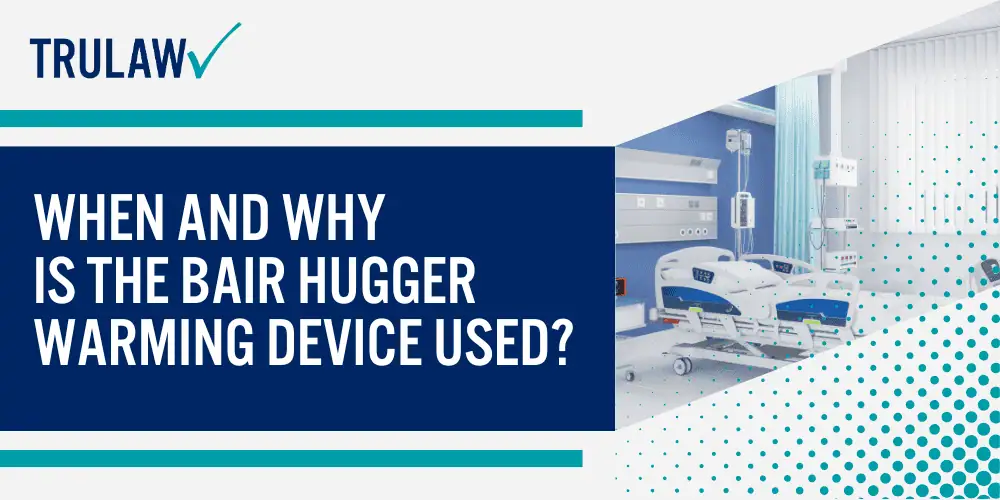
Given their widespread adoption, especially in surgeries requiring strict temperature management like orthopedic procedures, there is a high likelihood they were used if your operation occurred in a well-equipped medical facility.
How Do I Know if a Bair Hugger Warming Blanket Was Used During My Surgery?
To determine if a Bair Hugger warming blanket was used during your surgery, you can request your medical records or speak directly with your surgical team.
Medical and surgical records typically document all equipment and methods used during procedures.
Additionally, the clinical staff involved in your care can provide insights into the specific warming methods applied during your procedure.
Lawyers can help you access and assess your medical records to understand if and when a Bair Hugger device was used in your surgical procedure.
Contact us today for a free consultation.
Allegations in the Bair Hugger Lawsuit
The Bair Hugger Warming System has come under fire due to allegations that its design is both defective and hazardous.
Plaintiffs have asserted that the device, which circulates warm air to prevent hypothermia during surgery, fails to meet essential safety standards.
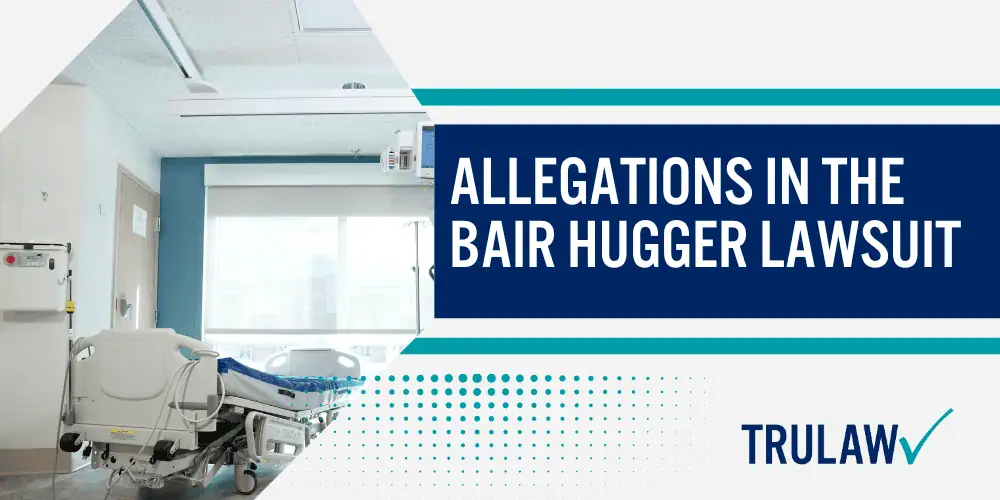
They argue that the system’s mechanism, particularly in the context of joint replacement surgeries, exposes patients to a higher risk of severe complications.
These claims underline concerns that the device may not be safe for its intended use.
Bair Hugger Blankets Allow Contamination of Wounds
Concerns have been raised regarding the potential for Bair Hugger blankets to contribute to airborne contamination in the operating room, particularly in the context of surgical site infections (SSIs).
The device’s mechanism, which involves drawing ambient air, warming it, and then releasing it through a perforated blanket, has been scrutinized for possibly introducing contaminants into the sterile field.
Some studies suggest that the Bair Hugger system might inadvertently draw contaminated air from the operating room floor, which could include bacteria, dust, or other particulates, and subsequently circulate this air near the surgical site.
This process creates a potential pathway for airborne bacteria to enter open surgical wounds, thereby increasing the risk of infection.
Several factors contribute to this concern:
- The Bair Hugger system’s method of air circulation could draw in contaminated air from less sterile areas of the operating room.
- The possibility that the warm air released by the blanket might disrupt the laminar airflow designed to protect the surgical site, thereby facilitating the movement of airborne contaminants.
- Reports that some patients have experienced infections following surgeries where Bair Hugger blankets were used, leading to questions about the device’s safety profile in certain surgical environments.
The potential for airborne contamination has sparked debates among healthcare professionals and has led to increased scrutiny of Bair Hugger blankets.
While the device is designed to prevent hypothermia, which is a key concern during surgery, the possibility of it contributing to SSIs cannot be disregarded.
Further investigations and controlled studies are needed to assess whether modifications in the use of the Bair Hugger system or alternative warming methods could mitigate these risks while still providing the necessary thermal regulation for patients.
3M Accused of Concealing Bair Hugger Infection Risks
The allegations against 3M center around the claim that the companies deliberately concealed and discredited scientific data regarding the risks associated with the Bair Hugger system.
According to the lawsuits, 3M was aware that the device could potentially increase the risk of deep joint infections, particularly during hip and knee replacement surgeries.
However, rather than addressing these concerns transparently, the company is accused of actively suppressing this information.
This alleged concealment forms a core component of the legal actions brought against the company.
To break down the key allegations:
- Plaintiffs claim 3M was aware of infection risks linked to the Bair Hugger system but chose to suppress this information.
- It is also alleged that 3M failed to provide adequate warnings to medical professionals and patients about these risks.
- The company has been accused of discrediting scientific studies that suggested potential dangers associated with the device.
In response to these allegations, 3M has consistently defended the Bair Hugger system, asserting that it is safe for use.
The company points to the lack of definitive studies proving a direct link between the device and increased infection risks as a basis for its defense.
Injuries Claimed in the Bair Hugger Infection Lawsuit
Patients involved in the Bair Hugger lawsuit report a range of serious injuries.
The most common and severe are deep joint infections.
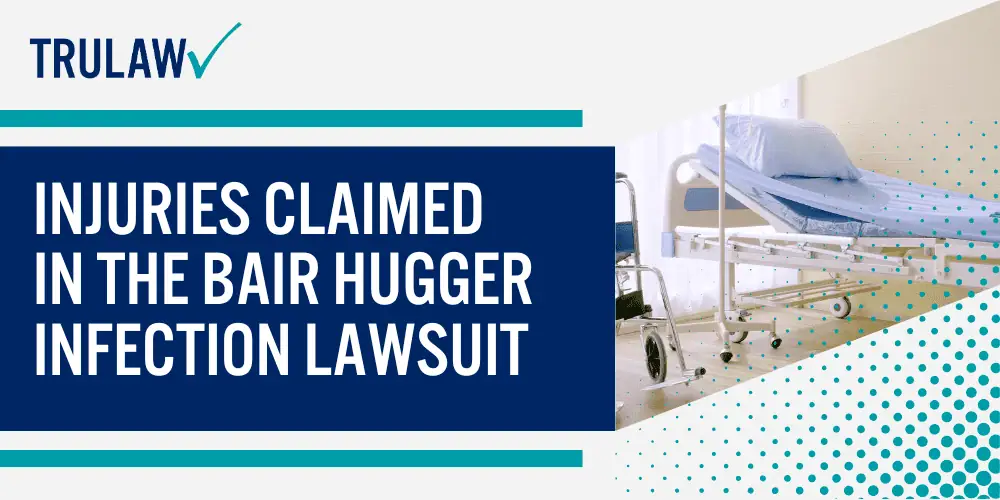
These infections can have long-lasting impacts on a patient’s health and quality of life.
Deep Joint Infections Require Surgical Treatment
Deep joint infections, particularly those involving prosthetic joints, present a formidable challenge due to their invasive nature and resistance to conservative treatments.
The American Academy of Orthopedic Surgeons (AAOS) emphasizes that once an infection infiltrates beyond the superficial layers and reaches a prosthetic joint, surgical intervention becomes nearly inevitable.
Several key surgical techniques are commonly employed in the management of deep joint infections:
- Debridement: The removal of necrotic and infected tissue to reduce bacterial load.
- Use of Antibiotic Spacers: Temporary devices that maintain joint function while delivering localized antibiotic therapy.
- Modular Component Exchange: Replacement of accessible prosthetic components that may harbor bacteria.
Each of these surgical methods plays a pivotal role in addressing the challenges posed by deep joint infections.
For instance, debridement is often coupled with a massive lavage of the joint using antiseptic solutions.
Antibiotics alone are often insufficient, as they may not effectively penetrate the deeper tissues or the biofilm that forms on prosthetic surfaces.
Bair Hugger Infections Causing Long-Term Harm
Contaminants introduced into open wounds or onto surgical instruments, may lead to deep joint infections.
These infections have been linked to severe, long-lasting consequences, including the need for additional surgeries, ongoing pain, and, in some cases, amputations.
Several complications have been reported in relation to the Bair Hugger warming system, with the most concerning being the potential for severe infections following deep joint surgeries.
These complications have been documented in reports to the FDA and include:
- Skin rashes
- Burns
- Hypothermia
- Serious infections
In particular, the infections associated with the device pose a substantial risk of long-term harm, especially in the context of surgeries involving deep joints.
These infections can be difficult to treat and may lead to prolonged pain and suffering, as well as necessitate further medical interventions.
Bair Hugger Lawsuit Implications for Medical Device Industry
The Bair Hugger litigation has broader implications for the medical device industry.
This case highlights the importance of ongoing safety monitoring and transparent communication about potential risks.
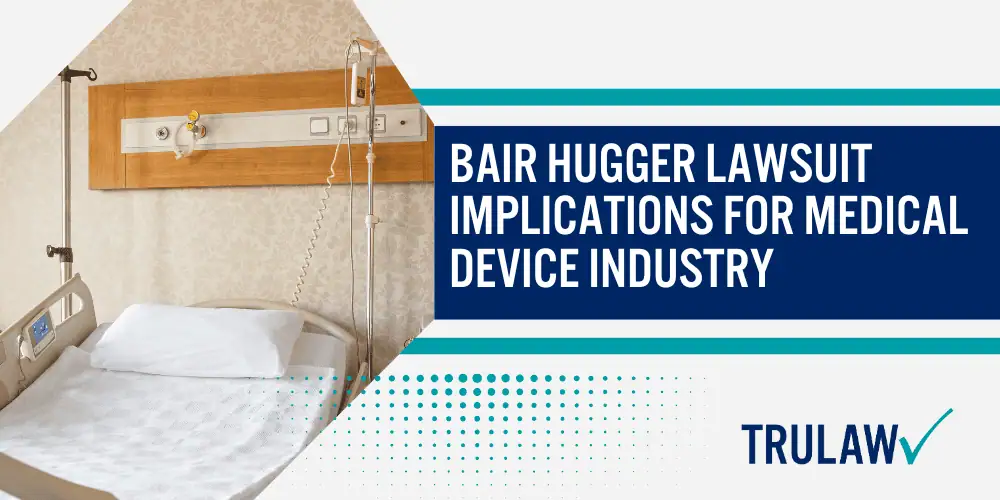
The outcome could influence future medical device lawsuits and regulatory practices.
Impact on Future Medical Device Litigation
The Bair Hugger MDL (Multidistrict Litigation) may set important precedents for similar cases.
It emphasizes the need for manufacturers to continuously evaluate their products’ safety.
This case could influence how courts handle evidence in medical device lawsuits.
This increased scrutiny may expose companies to a greater risk of lawsuits, particularly if they fail to meet these enhanced requirements.
Additionally, regulatory pressures concerning sterilization processes could disrupt the supply chain.
Changes in Hospital Practices Due to the Bair Hugger Lawsuit
In response to the mounting legal pressures associated with the Bair Hugger warming blanket, hospitals have begun to reassess their practices and protocols concerning forced air warming devices during surgery. The legal allegations against 3M have raised concerns about the safety of the Bair Hugger device, particularly in relation to its potential to increase the risk of infections during surgeries such as hip and knee replacements. As hospitals seek to protect patient safety and minimize legal exposure, several adjustments in practices are being implemented.
Hospitals are now focusing on the following approaches to manage the risks linked to the Bair Hugger:
- Conducting comprehensive risk assessments to evaluate the safety of the Bair Hugger.
- Implementing stricter sterilization and air quality control measures in operating rooms.
- Exploring and adopting alternative patient warming devices that may pose fewer risks.
- Enhancing patient informed consent procedures to include detailed information about the potential risks of using the Bair Hugger forced air warming system.
Some facilities have already switched to alternative warming methods.
Many are implementing stricter protocols for maintaining sterile environments during surgery.
These changes aim to reduce the risk of surgical site infections, regardless of the warming method used.
Filing a Bair Hugger Lawsuit
Individuals who believe they’ve been harmed by a Bair Hugger device may be eligible to file a lawsuit.

Understanding the criteria for filing and the time limits involved is essential for potential plaintiffs.
Who is Eligible to File a Bair Hugger Lawsuit?
The Bair Hugger blanket is at the center of a series of lawsuits alleging that the device may cause serious complications during surgical procedures.
These legal actions are primarily directed at the manufacturer, 3M, and focus on the potential health risks associated with the device, particularly the risk of infections during surgeries like hip and knee replacements.
Individuals who have experienced adverse health outcomes following the use of the Bair Hugger warming blanket may have grounds to pursue legal action.
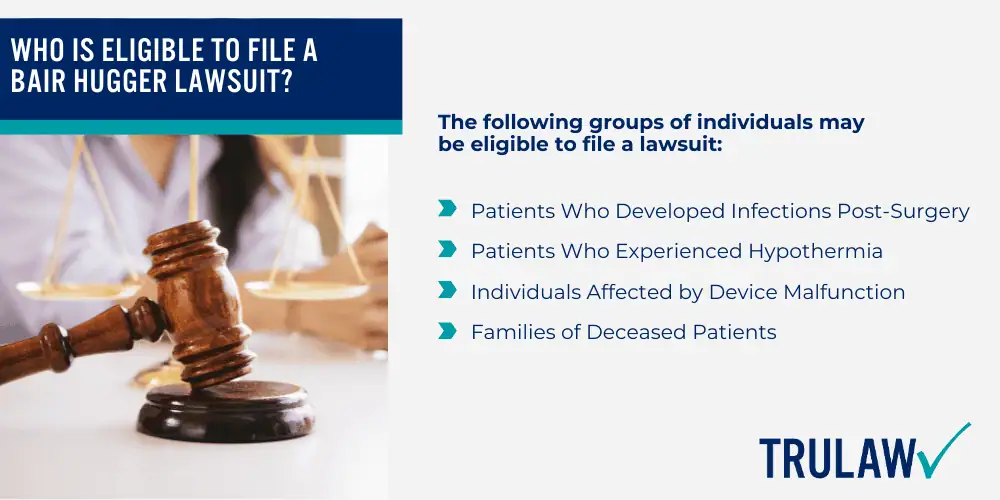
The following groups of individuals may be eligible to file a lawsuit:
- Patients Who Developed Infections Post-Surgery: Those who have experienced infections, particularly deep joint infections, following surgeries where the Bair Hugger warming blanket was used.
- Patients Who Experienced Hypothermia: Individuals who suffered from hypothermia during or after surgery, which may have been caused by the Bair Hugger system failing to adequately warm them.
- Individuals Affected by Device Malfunction: Patients who were harmed due to a malfunction of the Bair Hugger device, which contributed directly to negative health outcomes.
- Families of Deceased Patients: Next of kin of patients who died as a result of complications allegedly linked to the Bair Hugger warming blanket.
Eligibility to file a lawsuit is influenced by various factors, including the specific health issues encountered and the timing of these issues in relation to the use of the Bair Hugger device.
Patients and families affected by the device’s complications should seek legal advice to determine the viability of their case and the potential for compensation.
Statutes of Limitations on Bair Hugger Claims
When considering Bair Hugger claims, the statute of limitations plays a pivotal role in determining whether a lawsuit can proceed in federal court. This legal time limit requires plaintiffs to file their claims within a specific period, which varies depending on the jurisdiction and the details of each case. Missing this deadline can result in the dismissal of a claim, regardless of its merits.
For plaintiffs, there are several factors to consider when filing a claim:
- The specific statute of limitations in their jurisdiction.
- The timing of symptom onset or injury discovery.
- Procedural requirements such as pre-filing applications.
A case that underscores the importance of these factors is Georges v. Logan Health, where the plaintiffs faced challenges due to delays in filing within the required timeframe.
Here, 3M argued that the plaintiffs did not meet the mandatory procedural steps before filing their lawsuit and that their claims were time-barred.
The case illustrates how procedural missteps or delays can jeopardize the ability to obtain compensation.
TruLaw: Accepting Clients for the Bair Hugger Lawsuit
Bair Hugger lawsuits are being filed by individuals across the country who developed severe infections after undergoing surgery involving the use of Bair Hugger forced air warming blankets.
TruLaw is currently accepting clients for the Bair Hugger lawsuit.
A few reasons to choose TruLaw for your Bair Hugger lawsuit include:
- If We Don’t Win, You Don’t Pay: The Bair Hugger lawyers at TruLaw and our partner firms operate on a contingency fee basis, meaning we only get paid if you win.
- Expertise: We have years of experience handling medical device cases similar to the Bair Hugger lawsuit, which helps us anticipate what we can expect to see in your case and the regulations we will be required to meet.
- Successful Track Record: TruLaw and our partner law firms have helped our clients recover billions of dollars in compensation through verdicts and negotiated settlements.
If you or a loved one developed a severe infection after surgery involving the use of a Bair Hugger forced-air warming blanket, you may be eligible to seek compensation.
Contact TruLaw using the chat on this page to receive an instant case evaluation that can determine if you qualify for the Bair Hugger lawsuit today.
Bair Hugger Lawsuit Frequently Asked Questions
-
Who is eligible to file a Bair Hugger lawsuit?
Individuals who have experienced adverse health outcomes, such as infections or hypothermia, following the use of the Bair Hugger warming blanket may be eligible to file a lawsuit.
The time limit for filing varies by state, generally starting when the patient discovers or should have discovered their injury.
District Judge Joan Ericksen is currently overseeing the multidistrict litigation.
-
What is the Bair Hugger warming blanket and how does it work?
The Bair Hugger warming blanket is a device used during surgeries to maintain patients’ body temperature.
It works by drawing air from the operating room, warming it, and releasing it through a disposable blanket placed over the patient.
-
How can the Bair Hugger warming system potentially cause infections during surgery?
The Bair Hugger system may introduce harmful bacteria into surgical sites by drawing air from the operating room, which could contain airborne contaminants.
This warmed air is then released near the surgical site, potentially carrying bacteria into open wounds.
-
What types of surgeries have the highest risk of Bair Hugger-related infections?
Knee replacement surgery appears to have the highest risk of Bair Hugger-related infections due to the depth of the surgical site and the presence of implants.
Patients undergoing hip or shoulder replacements should also be aware of this potential risk.
-
What are the allegations against 3M in the Bair Hugger lawsuit?
The allegations against 3M claim that the company deliberately concealed and discredited scientific data regarding the infection risks associated with the Bair Hugger system.
Plaintiffs argue that 3M was aware of these risks but failed to provide adequate warnings to medical professionals and patients.
-
What injuries are claimed in the Bair Hugger infection lawsuit?
The most common and severe injuries claimed in the Bair Hugger lawsuit are deep joint infections, which often require multiple surgeries, long-term antibiotic therapy, and can result in chronic pain, reduced mobility, and permanent disability.
The lawsuit seeks compensation for these ongoing health issues and related financial losses.

Managing Attorney & Owner
With over 25 years of legal experience, Jessica Paluch-Hoerman is an Illinois lawyer, a CPA, and a mother of three. She spent the first decade of her career working as an international tax attorney at Deloitte.
In 2009, Jessie co-founded her own law firm with her husband – which has scaled to over 30 employees since its conception.
In 2016, Jessie founded TruLaw, which allows her to collaborate with attorneys and legal experts across the United States on a daily basis. This hypervaluable network of experts is what enables her to share the most reliable, accurate, and up-to-date legal information with our readers!
Additional Bair Hugger Lawsuit resources on our website:
Here, at TruLaw, we’re committed to helping victims get the justice they deserve.
Alongside our partner law firms, we have successfully collected over $3 Billion in verdicts and settlements on behalf of injured individuals.
Would you like our help?
At TruLaw, we fiercely combat corporations that endanger individuals’ well-being. If you’ve suffered injuries and believe these well-funded entities should be held accountable, we’re here for you.
With TruLaw, you gain access to successful and seasoned lawyers who maximize your chances of success. Our lawyers invest in you—they do not receive a dime until your lawsuit reaches a successful resolution!
AFFF Lawsuit claims are being filed against manufacturers of aqueous film-forming foam (AFFF), commonly used in firefighting.
Claims allege that companies such as 3M, DuPont, and Tyco Fire Products failed to adequately warn users about the potential dangers of AFFF exposure — including increased risks of various cancers and diseases.
Depo Provera Lawsuit claims are being filed by individuals who allege they developed meningioma (a type of brain tumor) after receiving Depo-Provera birth control injections.
A 2024 study found that women using Depo-Provera for at least 1 year are five times more likely to develop meningioma brain tumors compared to those not using the drug.
Suboxone Tooth Decay Lawsuit claims are being filed against Indivior, the manufacturer of Suboxone, a medication used to treat opioid addiction.
Claims allege that Indivior failed to adequately warn users about the potential dangers of severe tooth decay and dental injuries associated with Suboxone’s sublingual film version.
Social Media Harm Lawsuits are being filed against social media companies for allegedly causing mental health issues in children and teens.
Claims allege that companies like Meta, Google, ByteDance, and Snap designed addictive platforms that led to anxiety, depression, and other mental health issues without adequately warning users or parents.
Transvaginal Mesh Lawsuits are being filed against manufacturers of transvaginal mesh products used to treat pelvic organ prolapse (POP) and stress urinary incontinence (SUI).
Claims allege that companies like Ethicon, C.R. Bard, and Boston Scientific failed to adequately warn about potential dangers — including erosion, pain, and infection.
Bair Hugger Warming Blanket Lawsuits involve claims against 3M — alleging their surgical warming blankets caused severe infections and complications (particularly in hip and knee replacement surgeries).
Plaintiffs claim 3M failed to warn about potential risks — despite knowing about increased risk of deep joint infections since 2011.
Baby Formula NEC Lawsuit claims are being filed against manufacturers of cow’s milk-based baby formula products.
Claims allege that companies like Abbott Laboratories (Similac) and Mead Johnson & Company (Enfamil) failed to warn about the increased risk of necrotizing enterocolitis (NEC) in premature infants.
Here, at TruLaw, we’re committed to helping victims get the justice they deserve.
Alongside our partner law firms, we have successfully collected over $3 Billion in verdicts and settlements on behalf of injured individuals.
Would you like our help?
